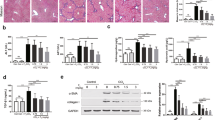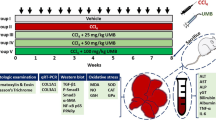Abstract
Inflammation plays an important role in the occurrence and development of fibrosis. Lipoxins (LXs) and BML-111 (lipoxin A4 agonist) have been approved for potent anti-inflammatory properties. Previously, we and others had showed LXs and BML-111 could protect acute hepatic injury, inhibit the growth and invasion of hepatic tumor. However, there are few reports dealing with their effects on hepatic fibrosis. To explore whether LXs and the analog could interrupt the process of hepatic fibrosis, the effects of BML-111 on tetrachloride-induced hepatic fibrosis were observed and the possible mechanism were discussed. Sprague–Dawley rats were induced liver fibrosis by carbon tetrachloride (CCl4) for 10 weeks with or without BML-111, and the histopathology and collagen content were employed to quantify hepatic necro-inflammation and fibrosis. Moreover, the expression levels of α-smooth muscle actin (α-SMA), transforming growth factor-β1 (TGF-β1), and platelet-derived growth factor (PDGF) were examined via Western blot or ELISA. Rats treated with BML-111 improved hepatic necro-inflammation and inhibited hepatic fibrosis in association with reduction of α-SMA expression and decreased collagen deposition. Furthermore, BML-111 could downregulate the expressions of TGF-β1 and PDGF significantly. BML-111 played a critical protective role in CCl4-induced hepatic fibrosis through inhibiting the levels of TGF-β1 and PDGF in rats.





Similar content being viewed by others

References
Serhan, C.N. 2002. Lipoxin and aspirin-triggered 15-epi-lipoxin biosynthesis: an update and role in anti-inflammation and pro-resolution. Prostaglandins & Other Lipid Mediators 68–69: 433–455.
Fiorucci, S., J.L. Wallace, A. Mencarelli, et al. 2004. A beta-oxidation-resistant lipoxin A4 analog treats hapten-induced colitis by attenuating inflammation and immune dysfunction. Proceedings of the National Academy of Sciences of the United States of America 101: 15736–15741.
McMahon, B., S. Mitchell, H.R. Brady, et al. 2001. Lipoxins: revelations on resolution. Trends in Pharmacological Sciences 22: 391–395.
O'Meara, Y.M., and H.R. Brady. 1997. Lipoxins, leukocyte recruitment and the resolution phase of acute glomerulonephritis. Kidney International. Supplement 58: S56–S61.
Diamond, P., A. McGinty, D. Sugrue, et al. 1999. Regulation of leukocyte trafficking by lipoxins. Clinical Chemistry and Laboratory Medicine 37(3): 293–297.
Machado, F.S., J.E. Johndrow, L. Esper, et al. 2006. Anti-inflammatory actions of lipoxin A4 and aspirin-triggered lipoxin are SOCS-2 dependent. Nature Medicine 12: 330–334.
Chiang, N., M. Arita, and C.N. Serhan. 2005. Anti-inflammatory circuitry: lipoxin, aspirin-triggered lipoxins and their receptor ALX. Prostaglandins, Leukotrienes, and Essential Fatty Acids 73: 163–177.
Mitchell, S., G. Thomas, K. Harvey, et al. 2002. Lipoxins, aspirin-triggered epi-lipoxins, lipoxin stable analogues, and the resolution of inflammation: stimulation of macrophage phagocytosis of apoptotic neutrophils in vivo. Journal of the American Society of Nephrology 13: 2497–2507.
Serhan, C.N., J.F. Maddox, N.A. Petasis, et al. 1995. Design of lipoxin A4 stable analogs that block transmigration and adhesion of human neutrophils. Biochemistry 34(44): 14609–14615.
Lee, T.H., P. Lympany, and A.E. Crea. 1991. Inhibition of leukotriene B4-induced neutrophil migration by lipoxin A4: structure–function relationships. Biochemical and Biophysical Research Communications 180(3): 1416–1421.
Zhang, L., J. Wan, H. Li, et al. 2007. Protective effects of BML-111, a lipoxin A(4) receptor agonist, on carbon tetrachloride-induced liver injury in mice. Hepatology Research 37(11): 948–956.
Gong, J., S. Guo, H.B. Li, et al. 2012. BML-111, a lipoxin receptor agonist, protects haemorrhagic shock-induced acute lung injury in rats. Resuscitation 83(7): 907–912.
Wang Q, Li R, Ying BY, et al. 2013 Mar 7. Lipoxin A4 activates alveolar epithelial ENaC, Na, K-ATPase and increases alveolar fluid clearance. American Journal of Respiratory Cell and Molecular Biology.
Lin, F., P. Zeng, Z. Xu, et al. 2012. Treatment of Lipoxin A(4) and its analogue on low-dose endotoxin induced preeclampsia in rat and possible mechanisms. Reproductive Toxicology 34(4): 677–685.
Pei, L., J. Zhang, F. Zhao, et al. 2011. Annexin 1 exerts anti-nociceptive effects after peripheral inflammatory pain through formyl-peptide-receptor-like 1 in rat dorsal root ganglion. British Journal of Anaesthesia 107(6): 948–958.
Conte, F.P., O. Menezes-de-Lima Jr., W.A. Verri Jr., et al. 2010. Lipoxin A(4) attenuates zymosan-induced arthritis by modulating endothelin-1 and its effects. British Journal of Pharmacology 161(4): 911–924.
Zhang, L., X. Zhang, P. Wu, et al. 2008. BML-111, a lipoxin receptor agonist, modulates the immune response and reduces the severity of collagen-induced arthritis. Inflammation Research 57(4): 157–162.
Zhou, X.Y., Y.S. Li, P. Wu, et al. 2009. Lipoxin A4 inhibited hepatocyte growth factor-induced invasion of human hepatoma cells. Hepatology Research 39: 921–930.
Hao, H., M. Liu, P. Wu, et al. 2011. Lipoxin A4 and its analog suppress hepatocellular carcinoma via remodeling tumor microenvironment. Cancer Letters 309: 85–94.
Chen, Y., H. Hao, S. He, et al. 2010. Lipoxin A4 and its analogue suppress the tumor growth of transplanted H22 in mice: the role of antiangiogenesis. Molecular Cancer Therapeutics 9: 2164–2174.
Iredale, J.P. 2007. Models of liver fibrosis: exploring the dynamic nature of inflammation and repair in a solid organ. The Journal of Clinical Investigation 117: 539–548.
Kodama, T., T. Takehara, H. Hikita, et al. 2011. Increases in p53 expression induce CTGF synthesis by mouse and human hepatocytes and result in liver fibrosis in mice. The Journal of Clinical Investigation 121: 3343–3356.
Gressner, A.M., and R. Weiskirchen. 2006. Modern pathogenetic concepts of liver fibrosis suggest stellate cells and TGF-beta as major players and therapeutic targets. Journal of Cellular and Molecular Medicine 10: 76–99.
Hernandez-Gea, V., and S.L. Friedman. 2011. Pathogenesis of liver fibrosis. Annual Review of Pathology 6: 425–456.
Friedman, S.L. 2008. Hepatic fibrosis—overview. Toxicology 254: 120–129.
Nissen, N.N., and P. Martin. 2002. Hepatocellular carcinoma: the high-risk patient. Journal of Clinical Gastroenterology 35: S79–S85.
Bataller, R., and D.A. Brenner. 2005. Liver fibrosis. The Journal of Clinical Investigation 115: 209–218.
Friedman, S.L. 2010. Evolving challenges in hepatic fibrosis. Nature Reviews. Gastroenterology & Hepatology 7: 425–436.
Friedman, S.L. 2008. Mechanisms of hepatic fibrogenesis. Gastroenterology 134: 1655–1669.
Leask, A., and D.J. Abraham. 2004. TGF-beta signaling and the fibrotic response. The FASEB Journal 18: 816–827.
Börgeson, E., N.G. Docherty, M. Murphy, et al. 2011. Lipoxin A4 and benzo-lipoxin A4 attenuate experimental renal fibrosis. The FASEB Journal 25: 2967–2979.
Lawrence, T., and D.W. Gilroy. 2007. Chronic inflammation: a failure of resolution? International Journal of Experimental Pathology 88(2): 85–94.
Acknowledgments
This work was supported by the National Natural Science Foundation of China (no. 81100299), Science and Technology Plan of Department of Health of Jiangxi Province (no. 20122020), and Natural Science Foundation of Jiangxi province (no. 20114BAB215010).
Author information
Authors and Affiliations
Corresponding author
Additional information
Xiao-Yan Zhou and Zhong-Jian Yu contributed equally to this paper.
Rights and permissions
About this article
Cite this article
Zhou, XY., Yu, ZJ., Yan, D. et al. BML-11, A Lipoxin Receptor Agonist, Protected Carbon Tetrachloride-Induced Hepatic Fibrosis in Rats. Inflammation 36, 1101–1106 (2013). https://doi.org/10.1007/s10753-013-9643-x
Published:
Issue Date:
DOI: https://doi.org/10.1007/s10753-013-9643-x



